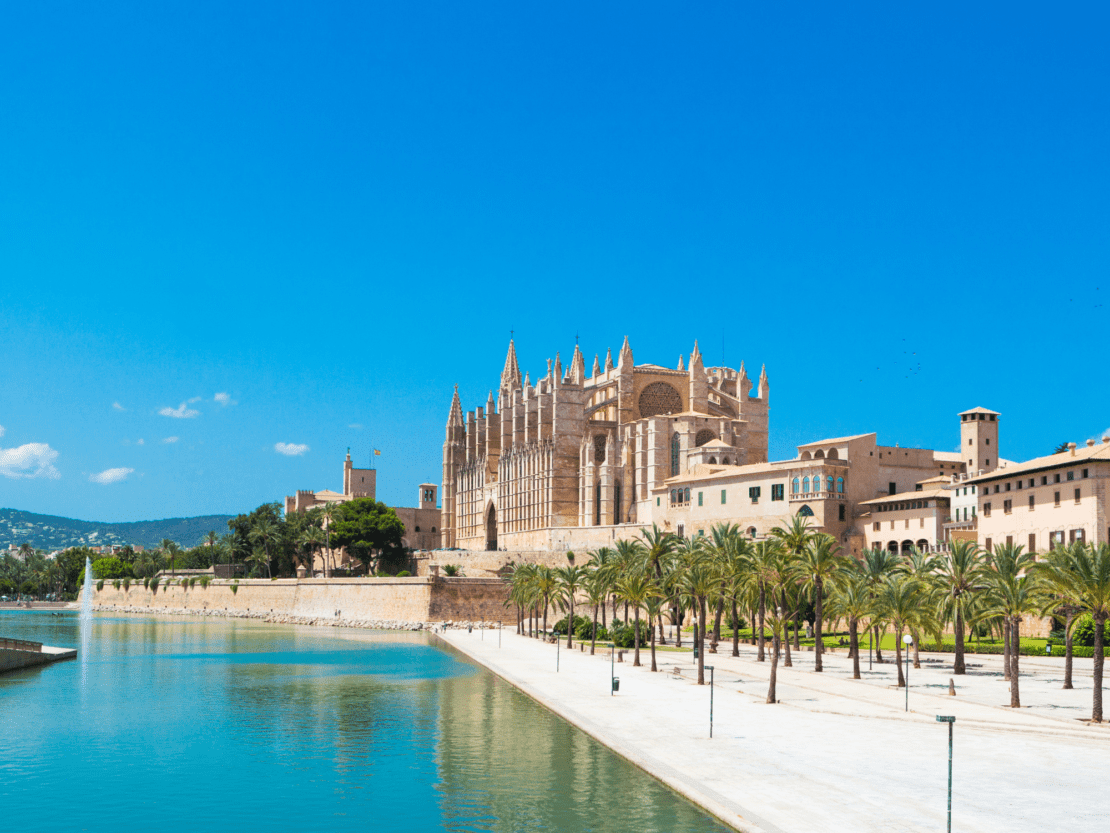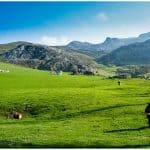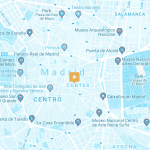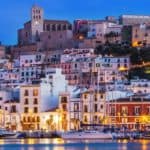Sunny days, golden sandstone cathedrals, and probably the bluest waters in the world… Welcome to Palma de Mallorca! Make the most of 24 hours in the capital of the Balearics with this guide on how to spend one day in Mallorca.

One Day in Palma Mallorca
The capital of the Balearic Islands looks almost unreal when you first look at it in a magazine. And everything becomes more outlandish when you finally find yourself in front of its cathedral. Or stroll around at night on the promenade, inhaling the salty air of the Med.
Some people arrive in Palma and never leave (like the famous English poet Robert Graves.) And once you visit, it’s easy to see why.
But if you are on the run and always eager to discover new places, this beautiful city has all it takes to surprise you in one day. Follow this Palma de Mallorca itinerary and hit the most exciting tourist attractions whilst soaking in the island vibe of Spain.
A Few Fun Facts about Palma De Mallorca
- The initial name of the island was ‘Insula Major’, which meant ‘larger island’ in Latin. But foreigners kept mispronouncing it, calling it Mallorca or Majorca, and this is how it stayed. Its capital, Palma, received its name from the ancient town of Palmeria, which the Romans built on the island.
- The island was a hot spot for invaders over the centuries, with attacks from the Romans, Moors, and Christian Kingdoms.
- Mallorca’s Serra de Tramuntana Mountain range is so stunning it was awarded World Heritage Status by UNESCO in 2011.
- It took 400 years for the immense La Seu cathedral to be completed.
- Almost half of the population of Mallorca lives in Palma.
When to Visit Palma de Mallorca
June, July, and August are considered the best months to visit Palma de Mallorca. During the summer, the temperatures reach 30-35 degrees Celsius and the waters of the Mediterranean heat to 25 degrees, attracting swimmers and sunbathers who appreciate the weather.
But Palma stays a warm place in the autumn as well. The resorts and restaurants are calmer at this time of the year, whilst the waters are perfect for snorkelling.
Winter puts the hotels to sleep as the temperatures drop to 17 degrees or lower. Yet, there are still plenty of great things to do. For instance, you can visit the cathedral without waiting in line for too long or explore the gorgeous beaches – alone.
If you are visiting in the spring, be prepared to be surprised by blooming trees and a the signs of nature coming back to life. This is the perfect time for shopping on Paseo del Borne, known as the most important shopping street on the island.
How to Get to Palma de Mallorca
Although an island, Mallorca is well connected to mainland Spain and other countries, offering variate transportation options.
Plane
The quickest way to travel to Palma is by plane. Palma de Mallorca Airport is only 8 kilometres from the capital and, contrary to most people’s expectations, it is a huge international hub transited by millions of tourists every year. It has connections to Madrid and Barcelona in Spain, almost all major cities in Europe, and some capitals outside it.
From the airport, you can take a shuttle bus, a public bus, or rent a car to take you to the city centre. Taxis are available as well, right next to the airport. Tourists who want to travel in style can have a helicopter pick them up and drop them off at their hotel.
Car
If you plan on visiting the entire island, driving is an excellent idea. You will be able to stop wherever you want and, more importantly, whenever you want. You can either pick up a rental car at the airport in Palma or take your car on a ferry from mainland Spain.
Coaches & Buses
Long-distance coaches will take you to your destination, but the trip is often far from being comfortable. You will be spending a day or more on the bus without being able to stretch your legs. For a vacation, it’s better to take the plane.
Although I’ve heard of people making friends on the bus and having a great time, so who knows? If you pick this option, Eurolines and Ouibus are among the biggest companies that include Palma on their routes.
Train & Ferry
Taking the train may be too much since you also need to continue your trip by ferry, but you can go for this combination if you have plenty of time to spare.
You will also have to take the ferry if you are travelling by car or bus.
Getting Around Palma de Mallorca
You can visit the best places in Palma without using public transportation or hiring a car. The city is small, and most attractions, except Bellver Castle, are placed in the Old Town, allowing you to follow an on-foot itinerary and enjoy the picturesque narrow streets and lively markets edged by palm trees and restaurants.
Yet, if you want to see more places on the same day, you can buy a tourist pass that will grant you free rides with the tour buses and entry to some of the most important attractions.
Bikes are also increasingly popular in Palma, and tourists are encouraged to use them for free. The only catch is, you need to bring them back by the end of the day.
How to Spend One Day in Palma de Mallorca
Palma’s Old Town is a great place to start your exploration. So, grab your camera and comfortable shoes, and start your one-day Palma de Mallorca itinerary right in the heart of the city.
The Arab Baths
Built during the time of the Moors in the 10th century but brought back to light only 100 years ago, the Arab Baths are possibly the only thing left from Medieval Palma. They were initially placed in the orchard of a manor house known as the Can Fontirroig, which probably belonged to a wealthy Moor.
Today the half-orange tepidarium, with its columns and shafts of shifting sunshine, is perfectly integrated into a garden. Some people like to come here to read or simply enjoy a sandwich when they get a break from their busy day. So, the purpose of the garden was preserved, as it was a good place for guests to cool off after taking a steamy bath.
Catedral de Mallorca
If you are travelling during the high season, you should head to the cathedral first, as it quickly becomes the busiest attraction in town. Everybody wants to see this magnificent 14th-century sandstone building rising on the shores of the Mediterranean and reaching straight for the skies.
The Cathedral of Santa Maria of Palma, also known as Le Seu, was built by King James I of Aragon after one voyage that he and his men took to the island. As they sailed toward it, they encountered a savage sea with strong winds and high waves that put them in great danger. The king swore that if they reached Mallorca safely, he would build a huge cathedral. And he kept his word, erecting one of the tallest cathedrals in Europe.
Built in Gothic style, La Seu underwent a series of changes in the 20th and 21st centuries when famous architect Antonio Gaudi added a massive crown-of-thorns illuminated canopy over the altar and Mallorcan artist Miquel Barceló remodelled the Chapel of the Holy Sacrament. Not everybody was thrilled by this last change, but you have to be there to form your own opinion.
As you enter the cathedral, you will be amazed by the multitude of stained glass windows (61 in total) that filter the light and add a rosy sheen across the floor and walls. This special design feature earned La Seu the name of ‘Cathedral of Light’.
If you are lucky enough to be in Palma exactly on February 2nd or on the 11th of November, you can witness a unique event. On these dates, the sun goes through the central rose window, reflecting it onto the opposite wall, right below the other rose window. Together they form a perfect figure of eight, and the phenomenon is a delight to watch.
Royal Palace of la Almudaina
Situated across from La Seu, the Palace of Almudaina used to be the seat of the Emir when Palma was under Arab rule. Later, in the Middle Ages, the Mallorcan kings used it as a residence, and today the king still holds official receptions here.
What’s special about the Almudaina is the combination of Gothic and Moorish styles that reflect the multiple cultural layers which influenced the architecture of the City of Palma.
First-time visitors find it intriguing and splendid at the same time, especially as they discover the 14th chapel of Saint Anna, with its enormous stained-glass window and beautifully decorated state apartments.
The best time to visit the palace is early in the morning or late in the afternoon so you get the chance to admire its grandeur without being pushed around by other tourists.
S’Hort del Rei
Outside the walls of the palace, you will find a splendid garden that encourages nature contemplation and relaxation. It is the perfect place to admire the exterior of the Palace of la Almudaina and imagine how the royal members spent their days walking among flowers and fruit trees. In the 14th century, S’Hort del Rei used to be planted with vegetables as well, and rabbits were bred on its premises.
Since then, the garden has been extended, with new elements added, like a pond with fountains and statues created by famous Mallorcan sculptors.
Sa Llotja
Back in the 15th century, Mallorca was a huge maritime trading centre, so it needed a place where merchants could haggle over spices, silk, and silver. This was Sa Llotja, the city’s exchange, placed very close to the dominating Palace of la Almudaina and overlooking the sea.
Since Palma is no longer a trade centre, this magnificent building now functions as a gallery of fine art, hosting temporary exhibitions. You may be lucky enough to find one. But even if you don’t, the building alone, with its superb towers, is worth visiting.
Plaça de Cort
Take a break in Plaça de Cort, the place where the feudal court used to gather. During the summer months, this charming square gathers a lot of tourists who come here to admire the ‘Olivera de Cort’.
This is a 600-year-old olive tree brought to Palma in 1989 from the Pedruixella Petit estate in Pollença as a sign of peace. Many people think they can see faces in it, especially an ear, which came to be known as the ‘Orella de Mallorca’.
You will find some nice restaurants around the square, so you can have lunch here or grab a coffee to keep you energised for the rest of the day.
Basilica de Sant Francesc
A peaceful 13th-century church with a lovely cloister edged by lemon and orange trees awaits you as the second part of your one-day Palma de Mallorca itinerary begins. Basilica de Sant Francesc is exactly as you expect it to be: massive but decorated with thin columns and the finest stained glass.
If you are a fan of Medieval philosophy, here you can visit the grave of Ramon Llull (1235-1316), the Catalan philosopher and mystic who believed that he could convert the Muslims in Tunisia to Christianity and got stoned to death for his efforts.
Also, check out the façade, which was rebuilt in the 17th century in a Baroque style after the church was hit by lightning.
Passeig des Born
You are now on the most elegant avenue in Palma, renowned for its upscale boutiques and luxury restaurants. Tourists stop on this street to shop for souvenirs or to enjoy a nice meal at one of the many terraces.
Since Louis Vuitton, Rolex, and Carolina Herrera have their shops here, the street goes by the nickname of The Golden Mile. And walking around is possibly the best way to feel Palma’s cosmopolitan vibe.
Dive with sharks at the aquarium
Take a break from the architecture and history and head underwater at the Palma Aquarium. You can learn plenty here without getting wet, through their audiovisual displays. But to really have a trip to remember, go swimming and dive with sharks in Majorca for real.
Mercat de Santa Catalina
Like most Spanish cities, Palma offers many places where you can both eat and buy fresh ingredients.
Mercat de Santa Catalina, in the bohemian Santa Catalina neighbourhood, is the oldest in Palma and sells seafood, fish, and other delicacies, amid the tomatoes and pumpkins. If you get up early, you’ll often spot chefs from the most renowned restaurants in town browsing here for the best ingredients they need.
Plaza Mayor
End the day in Plaza Mayor or Placa Major, as the English use to call it. It is a vibrant place today, bursting with life and fun, but things weren’t always so cheerful. The plaza is built on the site of the San Felipe Nerí Convent, which until 1838, was the seat of the Inquisition.
On some days of the week, the plaza hosts an artisan market, whilst in January, it functions as the starting point for the feast day of Sant Sebastià.
Spend your night here, walking around or settling at one of the many cosy restaurants and bars serving cooled wine and perfect Mallorcan or European dishes.
Discover Palma de Mallorca on a Cruise
Since many of the beautiful buildings of Palma are placed along the coast, a cruise or a boat trip can prove an amazing way to discover them. Imagine yourself gliding on the azure waters on a sunny day and going beyond Palma’s Old Town, to its tranquil golf courses and relaxing beaches. A cruise from the Port of Palma de Mallorca can provide you with a lovely view of the city and the chance to try out even more water-related activities.
One More Day to Spare in or near Palma Mallorca?
Although it is a small town, Palma’s borders don’t stop at its Old Town. If you have an extra day at your disposal, here are other attractions you could explore:
- Bellver Castle – this is the only circular Gothic castle in Spain, and since it sits on the pinnacle of Palma, it offers the best views over the city. Visit the Museu d’Historia de la Ciutat on its ground floor to find out more about its history as a military prison and discover the tumultuous past of Palma.
- Fundació Pilar i Joan Miró – this museum is a must if you are an art lover. But if you are not left with too much time on your first day, make sure to visit it on your second day in Palma. Juan Miro lived a part of his life here with his wife. Before their deaths, they founded this Fundacio and donated not only the house but many works of art you can now admire on the premises.
- Es Baluard – contemporary and modern art admirers could spend an hour or two discovering the intriguing exhibits at Es Baluard. Opened in 2004 by the King and Queen of Spain, the museum attracted over 55,000 visitors in the first month alone, and it remains one of the most popular cultural attractions on the island.
- Iglesia La Porciuncula (la Iglesia de Cristal) – for a mystical experience, stop by this marvellous church built upon concrete and iron ribs that hold an impressive 39 stained glass windows. Each of the windows tells a story inspired by the Bible or the tradition of the Franciscan order.
- Tren De Soller – take a day trip to the town of Sóller on an historic train that takes you on a striking route through the Serra de Tramuntana. Spend the day in Port de Soller, a picturesque fishing village that will welcome you with citrus-filled gardens, orange groves, and some of the best fish dishes on the island.
Where to Eat in Palma de Mallorca
Ca’n Joan de s’Aigo – if you want to taste the famous Ensaimada, a pastry product specific to Mallorca made with dough and saïm (a type of pork lard), you must stop by Ca’n Joan de s’Aigo. This cosy café situated on a narrow street in the city centre serves delicious desserts and coffee and is the perfect place to take a break after strolling around.
Asador Bolixe Cocina Esencial – if you are a big meat lover, this is where you dine in Palma de Mallorca. Quick service, amazing desserts, and the best steak in town combined with a sensational Mallorcan wine will make your day.
Fera Palma Restaurant – this is a world-class restaurant with a beautiful terrace situated in the Old Town. It has an elegant but cosy atmosphere and excellent dishes. The beef tartar nori and sea bass are simply out of this world.
Where to Stay in Palma de Mallorca
Nakar Hotel – This ultra-luxurious hotel is placed close to the Old Town, so it is perfect for city exploration. Tourists praise it for its excellent service and delicious breakfast options.
Posada Terra Santa – A gorgeous hotel with comfortable rooms, a pool and sauna that can be booked individually, and a cosy restaurant, the Posada Terra Santa will make you want to spend your whole day inside.
Hotel Costa Azul – if you are taking a romantic city break, Hotel Costa Azul, with its panoramic view of the Mediterranean Sea, is a fantastic choice. End your nights in the hotel’s excellent restaurant watching the moonlight gliding over the waters, and wake up to a dazzling blue sky every morning.
More Travel Articles about Spain
- The Spain quiz for curious people
- 49 Interesting facts about Spain
- Spain in one week: an itinerary for your first time in Spain
- How to plan a road trip through Andalucia
- Galicia: how to travel through the salty north of Spain
- The best road trips in Spain
- How to spend a summer in Spain
- Bilbao or San Sebastian for your next trip?
- The ultimate Spain packing list



